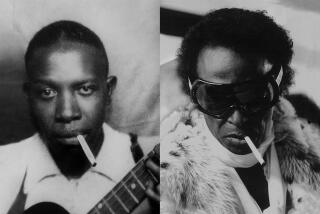A Builder’s Blueprint for the Arts : Patronage: Eli Broad, who knows his way around the construction industry, has some ideas about how to give the arts a firmer financial foundation.
- Share via
Few encouraging words are being heard from the culture crowd these days. Budgets are down. Expenses are up. Gifts and giving have shrunk and are shrinking. Hard times in our hallowed halls.
Then there’s Eli Broad.
The art patron/collector and business executive, a self-described “eclectic workaholic,” is going against the currents, moving upstream with his giving, at the same time floating some ideas about how some of the culture crowd might get together and do some sharing and some saving, a 10% solution for our times.
He has some different ideas about the seldom-revealed innards of art patronage and what gift-giving should do.
Broad has built a few houses in his 30-year business career and knows his way around plot plans and construction drawings. So he was on familiar territory as he unleashed drawings on the conference table in his high-rise Wilshire Boulevard office of Broad Inc.
The plans represent one of his current projects--an as-yet unannounced $2.5-million gift to Claremont’s Pitzer College where three buildings bearing his and his wife’s names will go up as part of a master plan for that campus. The buildings, which will contain visual and performing arts spaces, classrooms and offices, are designed to become the college’s landmark “gateway” at the northwest corner of the campus.
Then there’s CalArts in Valencia. Broad’s talk turns to the $440,000 complex that opened there a few weeks ago, a “row house” of 20 studios for painters and sculptors.
His talk also travels east to Michigan State, where he earlier announced a multi-year $20-million gift to the university’s business school for the development of a different type of executive, “people who would be real managers,” Broad says, “not MBA financial gurus.”
“All of these gifts represent years of work and phased giving over several years,” he says. “Don’t give the idea that it just happens easily or quickly. Otherwise, a long line would be forming outside waiting to see me.”
But why this spurt of giving in these hard times? Part of it, he explains, has to do with his workaholism, which he says enabled him to avoid most of the excesses of the over-leveraged ‘80s so that he would have something for the ‘90s and beyond. He also has a couple of philosophical reasons for his current giving.
“I like to give back. I don’t believe in accumulating wealth simply to pass it on to future generations. My family is comfortable.”
Is it time, then, to make a decision about his private foundation collection housed in a Santa Monica building and used as a “lending library” for museums filling out exhibits of contemporary artists?
When that building was opened four years ago, he indicated that by the year 2000 he would decide whether the works would be merged into one public museum or shared with several.
The deadline remains at 2000, he says. But right now he’s working on another idea:
“Look at today’s museums,” he says. “Most only have wall space to display about 10% of their permanent collections. And most museums seem to collect the same group of name artists. So here we have 10 museums that show only 10% of their collections 10% of the time and usually by the same artists.
“Why not a consortium of several collectors or museums so that you wouldn’t have these huge investments in works that are shown only part of the time? It would be like the Claremont Colleges where one library serves several campuses.
“Take Artist X. All the museums try to buy at least a small collection, say 10, of X’s works and they all have limited resources, wall space and storage. If they all joined forces and bought three paintings instead of 10 each and moved these works around through displays, those paintings would be shown 35% of the time instead of 10% of the time.
“That way the museums could use the resources that would have gone into buying the seven pictures they didn’t buy for other necessary things. I’ve tried the idea on some museum directors and they seem to like it in principle. If it would ever work I don’t know. There are a few political and ego problems involved.
“Perhaps the foundation collection might be the start of a consortium collection, but that I won’t decide until later.”
Until then Artist X won’t have to worry about a shrinking market from competing museum buyers.
In some respects, Broad’s private foundation collection has become a unilateral consortium of sorts, primarily lending out items from its 400-piece collection of contemporary artists. Broad who was founding chairman of Los Angeles’ Museum of Contemporary Art, says he “saw museums spending more and more money on just keeping their places up, on security, lighting, staffing, putting on exhibitions. At the bottom of the list were funds to acquire modern works of art. Contemporary artists were ending up increasingly in private collections here and overseas and the public was losing its chance to see these works. Our foundation became a lending library, an art evangelist of sorts, getting works to others, getting involved, sharing what we have.”
Collectors are also searched out and collected.
“Once your family is known to have wealth you are sought,” Broad says. “Any good development director reads Forbes and goes where the money is.”
It’s a subject not always examined.
Broad’s gift for new buildings at Pitzer goes back several years when Broad, who was a trustee, helped recruit Frank Ellsworth as college president.
“It started when Frank said he needed a building and came to me because of my interest in the arts. We started a dialogue and it went on for three or four years. We talked about what was needed. I told him that I thought Pitzer had gotten along without this proposed building for several years so why should we spend on bricks and mortar when there were other needs?
“We bantered and finally I reached a conclusion that it was more important than other options I had available. Pitzer’s mission in education is more important today than it’s ever been. We produce all the lawyers and consultants we need. We need people to help our society work better as a multiracial society. The Pitzer graduates go out to the world and do meaningful things for our society.”
The recent gift to CalArts also was the result of a campaign by another college president, Steven Lavine of CalArts. “He told me there was a need and asked me to go out there and see the campus. The school has produced many prominent artists and many are in our various collections. He showed me what they had in studios for students. It didn’t take much imagination and thought to agree that there was a real need for new studios there.”
Broad repeatedly talks of his recent gift-giving as a form of giving back, “in a manner that would make a difference,” whether it’s producing hands-on MBA candidates or hard-edged painters.
“Artists have a way of reflecting on what’s going on in society that is different from business people,” he says.
“Frankly, artists are more interesting to be with than a lot of business people I know.”
More to Read
The biggest entertainment stories
Get our big stories about Hollywood, film, television, music, arts, culture and more right in your inbox as soon as they publish.
You may occasionally receive promotional content from the Los Angeles Times.










